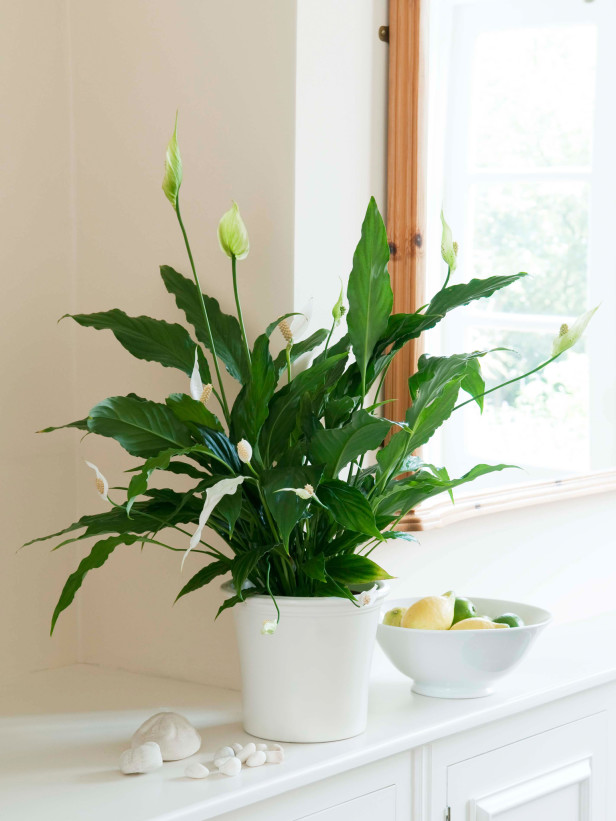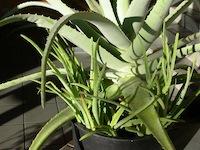|
Basic Plant Care Guide
Peace Lily Care Tips: Give Peace a Chance
- Robert George Tronge
Following these easy peace lily care steps will help yours thrive, not just survive.
 Peace lilies which are not true lilies, but a member of the Araceae family of flowering plants are renowned for their easy care. The peace lily is hardy, forgiving, and will even let you know when it is thirsty look for the telltale droop. The shade-loving tropical plant is also known for its air-purifying abilities it's great at breaking down and neutralizing toxic gases like carbon monoxide and formaldehyde.
Peace lilies which are not true lilies, but a member of the Araceae family of flowering plants are renowned for their easy care. The peace lily is hardy, forgiving, and will even let you know when it is thirsty look for the telltale droop. The shade-loving tropical plant is also known for its air-purifying abilities it's great at breaking down and neutralizing toxic gases like carbon monoxide and formaldehyde.
Talk about looking out for you! While peace lilies are known for their resilience, following these easy peace lily care steps that will help yours thrive, not just survive:
Light and Shade: Peace lilies love shade and some indirect light. A spot 5-7 feet away from a south- or west-facing window will often provide the right mix. Yellowing leaves, brown spots or streaks may mean that your plant is getting too much light, so try moving the plant a little further from the window or experiment with a new, less sunny location. Peace lilies can sometimes even do well under a fluorescent light without any sunlight at all! If you move your plant into a shadier location and its leaves are still brown, it may need a bit of misting on the leaves.
Temperature: Peace lilies like a consistent temperature between about 65 and 80 degrees F. Protect your plant from drafts and cold or drastic changes in temperature.
Fertilize: Spring and summer, use an organic fertilizer to help your plant bloom. Keep in mind that peace lilies are sensitive to chemical fertilizers, so organic options are best.
Water: Peace lilies like to be watered a lot at once, but also need a chance to dry out afterward. The plant will droop a bit when thirsty, telling you when it needs a drink! If you pay attention to when it usually starts to sag, you can plan to water one day before it generally happens. Watering about once a week and spritzing leaves with water throughout the summer will help keep your peace lily hydrated. If your plant seems to completely droop, don’t give up: water and spritz and give it a chance to revive. If your water is chlorine-heavy, let a container of water stand overnight before watering the plant.
Drainage: Peace lilies are susceptible to root rot, so it’s very important to make sure the plant has a chance to dry out between waterings and that the container it lives in drains well. If your peace lily starts to wilt, check the roots to make sure they are firm and light-colored rather than soggy.
Transplant: When your plant’s roots show or your peace lily seems to be drinking up all its water within a few days, re-pot into a larger container. Your plant may need to be gradually moved into larger and larger containers, but generally peace lilies won’t need to go into a pot larger than 10 inches.
Expect your peace lily to show off its familiar white blooms in the spring. The plant is mildly toxic to animals and humans, so keep away from small children and Fluffy, and wash your hands after handling your plant as it produces crystals that can irritate skin. Follow these peace lily care tips and, with some experimentation, your peace lily should bring beauty to your house for years to come!
-------------------------------------------------------------------------------------------------------------------
Aloe Vera - Robert
George Tronge

Description
Aloe Vera has variegated leaves that flow out from its center base. Aloe can be kept in a pot in the kitchen near a window for every day use. The juice from its leaves will relieve pain from scrapes and burns.
Sun Exposure:
Full Sun
Botanical Name:
Aloe barbadensis
Plant Type:
Houseplant
Planting
• Plant in wide containers with a well-draining potting mix, such as for cacti/succulents.
• Place in indirect sunlight or artificial light.
Care
• Water aloe deeply but then allow the soil to dry at least 1 to 2 inches deep between waterings, in order to discourage rot; water even less in
winter
• Aloe plants produce offsets or plantlets or “babies” that can be removed to produce an entirely new plant.
Knock your Aloe out of its pot and find where the offsets are attached. Sever them from the mother plant with a knife. Allow the cuts on the offsets and the mother plant to callus over for a day or two. Pot them in a standard potting mix. Put in a sunny location. Wait a week to water and keep the soil on the dry side.
Pests/Diseases
Aloes are prone to mealybugs and scale. Some common diseases are root rot, soft rot, fungal stem, and leaf rot.
-------------------------------------------------------------------------------------------------------------------
Houseplant Pests and Diseases
- Robert George Tronge
How to keep indoor plants healthy and pest-free
 Houseplants
Houseplants
Healthy houseplants need good air circulation, so it's important that they're not crowded. The Nesting Branch Plant Stand makes it easy to adjust spacing to accommodate growing plants.
MOST gardeners find growing a great tomato or a beautiful bed of zinnias is easier than keeping houseplants alive. It seems that one day they're fine and the next they're dropping leaves and are infested with aphids, mealybugs or spider mites.
5 Ways to Keep Houseplants Healthy
•Inspect plants before bringing them indoors. If they show signs of pests or disease, cure the problem before you infect your other indoor plants.
•Avoid placing plants in trouble spots, such as near heat or air conditioning ducts, on television or a radiator or between curtains and a frosty window.
•Provide the right light. Plants that require full sun will thrive in a south-facing window. East-and west-facing windows have moderate sun. North windows have very little sun.
•Remember that air conditions can be very dry in the winter because of heated air. You can provide a little extra humidity with a pebble tray and some misting.
•Always plant in sterile soil. That will minimize problems with fungus gnats and other soil-borne diseases.
It's actually not that difficult to keep houseplants happy, but you do need to pay attention to their basic needs, and take care of any pest problems right away. Here are some suggestions to help you have a green thumb indoors as well as out!
Know Your Plants
All plants need food, water and sunlight to survive, but different plants require different amounts of each. This is just as true with houseplants as it is for the plants in your garden. For example, ficus trees generally thrive with indirect light and moist soil, whereas cacti require bright light and dry soil.
Make sure you choose houseplants that will thrive on the amount of light you can provide. Healthy plants will be able to ward off pests and disease much better than weak plants.
Indoor plants also need regular fertilizing to maintain healthy growth. A great all-around fertilizer that can be added right to your watering can is Plant Health Care for Seedlings and Houseplants. It is a balanced formula that contains a 6-12-6 fertilizer, humic and amino acids, and
robert g tronge vitamins. As a general rule, most houseplants should be fertilized from January through September, and should then be allowed to "rest" for a few months.
Provide Consistent Water
Alternating periods of drought and flood can really stress a plant’s root system. Most plants like having their roots consistently moist, but not wet. Some plants prefer to dry out a bit between
waterings. For new plants, check the care label or consult a good indoor plant book. This will help you determine the right watering routine. Self-watering planters make it easier to keep plants watered.
Prevent Pest Problems
Neem Oil Spray
This natural, multipurpose pest control spray belongs in the tool shed of every gardener. Neem Oil Spray has natural potassium salts and potent neem tree oil, it works on a wide variety of pests including aphids, mites, white flies, flea beetles and earwigs. It even kills scale on your houseplants and tent caterpillars that destroy your trees. Also controls powdery mildew. Safe to use on indoor and outdoor plants, right up to the day of harvest.
When a houseplant gets attacked by an insect pest, the problem can quickly spread to other plants. Preventing insects from entering your home is key to indoor insect control.
Check houseplants for disease or insects before you buy them. Then isolate them for a couple weeks, just to make sure there are no problems. Each time you water your plants, inspect both sides of the leaves for signs of pests or disease. If you suspect anything, isolate the plant from your other plants until you have eliminated the problem.
Indoor Gardening
Bring nature indoors and enjoy gardening year-round with decorative displays, full-spectrum SunLite Gardens, seasonal plants and handy tools.
It is also a good idea to wash the leaves of your plants several times a year. Dust and grime on houseplants doesn't just look bad; it is also bad for the health of the plant. Dust clogs the "pores" of plant leaves, making it difficult for the plant to
respirate. In addition, dust filters sunlight before it reaches the plant, decreasing the amount of photosynthesis the plant can undertake. Dust and grime can also attract and harbor spider mites and other insect pests.
Wash smooth-leaved houseplants with a moist, soft cloth and some insecticidal soap, such as Neem Oil Spray. For plants with many small leaves, use a hand sprayer or sink sprayer to douse them with water. Another option is to place the plant under a shower head and spray it. In all cases, the water should be lukewarm — not cold or hot. You can add a few drops of mild liquid dishwashing soap or insecticidal soap to the water as well.
Never use a feather duster to clean plants, because dusters can easily transfer tiny insects or eggs from one plant to another.
-------------------------------------------------------------------------------------------------------------------
Information On Caring For Pothos Plants
- Robert George Tronge
The pothos plant is considered by many to be a great way to get started caring for houseplants. Because pothos care in easy and undemanding, this lovely plant is an easy way to add some green in your home.
 Caring for Pothos Plants
Caring for Pothos Plants
Basic pothos care is very easy. These plants enjoy a wide range of environments. They do well in bright indirect light as well as low light and can be grown in dry soil or in vases of water. They will thrive in nutrient rich soil, but do almost as well in nutrient poor soil.
Pothos plants make a great addition to you bathroom or office because they can tolerate low light. While
the robert tronge pothos likes a wide variety of light conditions, they do not do well in direct sunlight.
If your pothos is highly variegated — particularly variegated with white — they may either not grow as well in low light or may lose their variegation if the light is too low. Only the green parts of the leaves can make energy for the plant, so it must be able to get enough light for energy or its growth will slow or the leaves will compensate for the lack of light by becoming more green.
Pothos is very popular due to the fact that it can be grown in water or in dry soil. Cuttings can be taken from a mother plant and rooted in water and kept in water as a houseplant. This is convenient for placing a pothos plant in hard to reach areas in a jug of water where they can remain untouched as long as water remains in the jug. On the opposite end, pothos can also be started in soil and will tolerate moderate periods of dry soil with little effect to the plant. Oddly enough, cuttings started in one growing medium have a hard time switching to the other. So, a pothos plant started in soil has a hard time thriving if moved to water and a pothos cutting started in water will not do very well in soil, especially if it has spent a long period of time growing in water.
You can fertilize your pothos plant about once every three months and this will help the plant grow more quickly, but most people find that their plants grow quick enough even with being fertilized.
Are Pothos Plants Poisonous?
While pothos plants are an easy to care for houseplant, you do need to be aware that they are poisonous. Though rarely fatal, the plant can cause irritation and vomiting if ingested due to the fact that it contains calcium oxalates. Even the sap from the plant may cause highly sensitive people to break out in a rash. It is considered toxic to cats, dogs and children, but as mentioned, it normally will make them very sick but will not kill them.
-------------------------------------------------------------------------------------------------------------------
How to Care for Potted Plants
- Robert George Tronge
1. Choose the pots.
Make certain there are one or more holes in the bottom of your container to allow water to flow out freely. Insufficient drainage can cause roots to drown, and the plant to die prematurely.
 Almost anything can be used as a container for plants, so what type of pot you choose depends upon your style preference and budget. If you prefer lightweight containers, which are easy to move around and can weather winter temperatures, look for resin, fiberglass, and plastic. Bonus: These materials are not porous, so they absorb less moisture than unglazed clay or wood―leaving more for the plant.
Almost anything can be used as a container for plants, so what type of pot you choose depends upon your style preference and budget. If you prefer lightweight containers, which are easy to move around and can weather winter temperatures, look for resin, fiberglass, and plastic. Bonus: These materials are not porous, so they absorb less moisture than unglazed clay or wood―leaving more for the plant.
2. Choose the potting mix.
Do not use soil from the yard or garden. It can be filled with weed seeds, insects, and fungal diseases.
Buy potting soil at your local garden center. It is a loose and light mixture of materials like peat moss, vermiculite, and, often, decomposed organic matter. If you are planting succulents or cacti, use a mix especially formulated for them.
To reduce plant maintenance, buy potting mix containing a time-release fertilizer and moisture-retaining polymer crystals. If that type of mix is not available, buy a time-release fertilizer (such as Cockadoodle
Doo) and a jar of water-retaining crystals (like Soil Moist) and follow the package directions for adding to the potting mix.
3. Choose the plants.
Make “Right plant, right place” your motto. You must take into consideration the conditions of your space. Don’t try to grow a flower like a rose―which requires six hours of full sun―on a porch that gets only an hour in the early morning. Do your homework (read books and plant tags), ask for advice at the garden center, and determine which plants will thrive in the available sun or shade.
When deciding what to buy, the simplest approach is to use one kind of plant per pot. If you choose to combine multiple types of plants, make sure they all like the same light and moisture conditions. Don’t put a cactus and a pansy together in one pot and expect them to get along.
4. Prepare the pots.
If your containers are large, place them where they’ll ultimately go before filling them. Once they are full and watered, they may be too heavy to move.
Put a basket-type coffee filter or a shard of broken pot over the hole(s) in the bottom of the empty pot. This will prevent the potting mix from washing out but will still allow water to escape.
Before pouring in the soil, check its moisture content. Read directions on the bag for wetting it properly. Generally, you need to add water a little at a time and knead the mixture with your hands. A good rule of thumb is to wet the mix until it feels like a damp sponge.
Fill the container with the soil. Put in enough potting mix so the base of the plant (where the stem sprouts from the soil’s surface) is about 1 inch from the top of the pot (to help visually estimate, position your plant while it’s still in its nursery container). Before planting, pat down the soil lightly with your fingers to eliminate any big air pockets. Don’t pack it down too hard.
5. Pot the plant.
Remove the plant from its nursery container. (It’s a good practice to water plants in their original containers at least an hour before transplanting. This will ease their removal and diminish transplant shock.) Support the top of the “root ball” (the semisolid mass of soil and roots) by placing a finger on each side of the stem; then tip the pot and let the plant fall gently into your hand. Never pull a plant out by its stem. If it is stuck, tap the sides of the pot to loosen it.
If the roots are circling around and around, the plant is “root-bound.” Gently tease the ends of the roots free before planting.
Set the plant on top of the mix. If you are potting more than one plant, leave at least an inch or so around each root ball so you can add mix in between them. Carefully fill in with small handfuls of soil. Pat gently to eliminate air pockets. Do not pile soil on top of the plant―make sure the stem is completely above the surface. Leave about an inch between the soil surface and the rim of the pot.
Water the container. This will settle the roots into their new home. If the soil level drops below the top of the root ball, add additional mix to bring it back up.
Watering
If you plant in the spring and the weather is mild, you can probably get away with watering about once a week. As the summer continues, plants need more water. Not only is the warm weather evaporating the moisture before the plant can use it, the plants need more water as they grow larger. Hanging plants and small pots may need watering twice a day (best times are morning and evening); once a day is enough for large pots.
Water your plants until the water comes out of the drainage holes. That way you know the soil is getting moisture all the way to the bottom.
Water the soil, not the leaves and flowers. Wetting the foliage can lead to fungal diseases and sometimes scorched spots on leaves.
Don’t worry if plants and flowers look wilted in the hottest time of the day. As long as the top of the soil is moist, you probably don’t need to water. Wilting is a self-protective mechanism to prevent too much moisture loss from the root area. Wait and see if the plants perk up after the sun goes down.
Don’t let pots sit in water; this can cause root rot and death. If you are using saucers, empty them after you water and after it rains.
Feeding
Plants growing in containers need more fertilizing than those in the ground. The more you water, the more quickly you flush the nutrients out of the soil. It’s good to use a time-release fertilizer when planting (see “Step 2: Choose the
Robert Tronge Potting Mix”), but it’s the bare minimum. If you want really healthy and happy plants, feed them a liquid or water-soluble fertilizer every couple of weeks according to package directions.
Deadheading
Pinching or cutting off faded blooms, known as deadheading, is essential. It encourages a plant to keep producing more flowers.
Some plants have so many tiny flowers and stems, it would be too time-consuming to snip or pick off individual flower heads. For those types, it’s best to shear the whole plant back to about one-third of its size. It will look “whacked” for about a week, but you will soon be rewarded with a flush of new buds and blooms.
Some flowering plants are “self-cleaning,” meaning they don’t generally require deadheading or shearing. These are usually prolific bloomers covered in smallish flowers, which just shrivel up and almost disappear on their own. Some examples are impatiens, mini petunias,
diascia, and browalia. If they start to flag late in the summer, cut back the plant by one-third to rejuvenate blooming.
Good Container Flowers for Sun
Angelonia
African daisy (Arctotis)
Dahlia
Purple fountain grass (Pennisetum setaceum ‘Rubrum’)
Lantana
Verbena
Tuberous Begonia
Good Container Flowers for Shade
Fuchsia
Impatiens
Browallia
Torenia
Good, Colorful Foliage Plants for Sun and Shade
Caladium (shade)
Coleus (sun and shade, depending on variety)
Phormium (full sun to part shade)
Canna (full sun to part shade)
Ferns (various types, filtered sun to shade)
Persian shield (Strobilanthes dyerianus, full sun/part shade)
Ornamental sweet potato vine (Ipomoea batatas, full sun/part shade)
Ornamental grass (various types, full sun)
Good Container Flowers for Sun and Shade
Twinspur (Diascia, full sun/part shade)
Mini petunia (Calibrachoa, full sun/part shade)
Nemesia (full sun/part shade)
Scaevola (full sun/part shade)
Salvia (Salvia guaranitica, full sun/part shade)
Note: Where only one name is listed, the botanical and common names are the same.
|
![]()